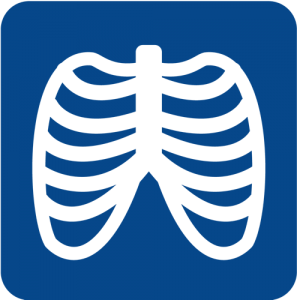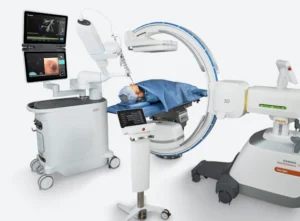Now Offering Televisits
Connecting with our providers is easier than ever.
Click to call our office at 813-875-9362 to schedule your televisit.
Lung Cancer Awareness Month
Lung cancer has no symptoms in early stages — learn more about early diagnosis and detection »

Our Services
Pulmonary Function Testing
Pulmonary function tests are a group of tests that measure how well the lungs take in and release air and how well they move gases such as oxygen from the atmosphere into the body’s circulation.
How the Test is Performed
Spirometry measures airflow. By measuring how much air you exhale, and how quickly, spirometry can evaluate a broad range of lung diseases. In a spirometry test, while you are sitting, you breathe into a mouthpiece that is connected to an instrument called a spirometer. The spirometer records the amount and the rate of air that you breathe in and out over a period of time.
For some of the test measurements, you can breathe normally and quietly. Other tests require forced inhalation or exhalation after a deep breath. Sometimes you will be asked to inhale the substance or a medicine to see how it changes your test results.
Lung volume measurement can be done in two ways:
- The most accurate way is to sit in a sealed, clear box that looks like a telephone booth (body plethysmograph) while breathing in and out into a mouthpiece. Changes in pressure inside the box help determine the lung volume.
- Lung volume can also be measured when you breathe nitrogen or helium gas through a tube for a certain period of time. The concentration of the gas in a chamber attached to the tube is measured to estimate the lung volume.
To measure diffusion capacity, you breathe a harmless gas, called a tracer gas, for a very short time, often for only one breath. The concentration of the gas in the air you breathe out is measured. The difference in the amount of gas inhaled and exhaled measures how effectively gas travels from the lungs into the blood. This test allows the doctor to estimate how well the lungs move oxygen from the air into the bloodstream.
How to Prepare for the Test
Do not eat a heavy meal before the test. Do not smoke for 4 – 6 hours before the test. You’ll get specific instructions if you need to stop using bronchodilators or inhaler medications. You may have to breathe in medication before or during the test.
How the Test Will Feel
Since the test involves some forced breathing and rapid breathing, you may have some temporary shortness of breath or lightheadedness. You breathe through a tight-fitting mouthpiece, and you’ll have nose clips.
Why the Test is Performed
Pulmonary function tests are done to:
- Diagnose certain types of lung disease (such as asthma, bronchitis, and emphysema)
- Find the cause of shortness of breath
- Measure whether exposure to chemicals at work affects lung function
- Check lung function before someone has surgery
It also can be done to:
- Assess the effect of medication
- Measure progress in disease treatment
Normal Results
Normal values are based upon your age, height, ethnicity, and sex. Normal results are expressed as a percentage. A value is usually considered abnormal if it is less than 80% of your predicted value.
Normal value ranges may vary slightly among different laboratories. Talk to your doctor about the meaning of your specific test results. Different measurements that may be found on your report after spirometry include:
- Expiratory reserve volume (ERV)
- Forced vital capacity (FVC)
- Forced expiratory volume (FEV)
- Forced expiratory flow 25% to 75%
- Functional residual capacity (FRC)
- Maximum voluntary ventilation (MVV)
- Residual volume (RV)
- Peak expiratory flow (PEF)
- Slow vital capacity (SVC)
- Total lung capacity (TLC)
What Abnormal Results Mean
Abnormal results usually mean that you may have some chest or lung disease.
Some lung diseases (such as emphysema, asthma, chronic bronchitis, and infections) can make the lungs contain too much air and take longer to empty. These lung diseases are called obstructive lung disorders.
Other lung diseases make the lungs scarred and smaller so that they contain too little air and are poor at transferring oxygen into the blood. Examples of these types of illnesses include:
- Extreme overweight
- Fibrosis of the lungs
- Lung cancer
- Sarcoidosis and scleroderma
Risks
The risk is minimal for most people. There is a small risk of collapsed lung in people with a certain type of lung disease. The test should not be given to a person who has experienced a recent heart attack, or who has certain other types of heart disease.
Considerations
Your cooperation while performing the test is crucial in order to get accurate results. A poor seal around the mouthpiece of the spirometer can give poor results that can’t be interpreted. Do not smoke before the test.
Alternative Names
PFTs; Spirometry; Spirogram; Lung function tests
References
Hegewald MJ, Crapo RO. Pulmonary function testing. In: Mason RJ, Broaddus VC, Martin TR, et al, eds. Murray and Nadel’s Textbook of Respiratory Medicine. 5th ed. Philadelphia, Pa: Saunders Elsevier; 2010:chap 24.
Reynolds HY. Respiratory structure and function: mechanisms and testing. In: Goldman L, Schafer AI, eds. Cecil Medicine. 24th ed. Philadelphia, PA: Saunders Elsevier; 2011:chap 85.
Update Date: 12/12/2011
Updated by: David C. Dugdale, III, MD, Professor of Medicine, Division of General Medicine, Department of Medicine, University of Washington School of Medicine; and Denis Hadjiliadis, MD, Assistant Professor of Medicine, Division of Pulmonary, Allergy and Critical Care, University of Pennsylvania, Philadelphia, PA. Also reviewed by David Zieve, MD, MHA, Medical Director, A.D.A.M., Inc.
Pulmonary Special Procedures
- Bronchoscopy
- EBUS Bronchoscopy
- Robotic Bronchoscopy — Learn More »
- Transbronchial Needle Biopsy
- Laser Therapy
- Endobronchial Valve Placement
- Airway Stent Placement
- Bronchial Thermoplasty
- Brachytherapy
- Thoracentesis
- Right Heart Catheterization
Sleep Studies
What Are Sleep Studies?
Sleep studies are tests that measure how well you sleep and how your body responds to sleep problems. These tests can help your doctor find out whether you have a sleep disorder and how severe it is.
Sleep studies are important because untreated sleep disorders can raise your risk for heart disease, high blood pressure, stroke, and other medical conditions. Sleep disorders also have been linked to an increased risk of injury, such as falling (in the elderly) and car accidents. People usually aren’t aware of their breathing and movements while sleeping. They may never think to talk to their doctors about issues that might be related to sleep problems.
However, sleep disorders can be treated. Talk with your doctor if you snore regularly or feel very tired while at work or school most days of the week.
You also may want to talk with your doctor if you often have trouble falling or staying asleep, or if you wake up too early and aren’t able to go back to sleep. These are common signs of a sleep disorder.
Your doctor might be able to diagnose a sleep disorder based on your sleep schedule and habits. However, he or she also might need the results from sleep studies and other medical tests to diagnose a sleep disorder.
Sleep studies can help diagnose:
- Sleep-related breathing disorders, such as sleep apnea
- Sleep-related seizure disorders
- Sleep-related movement disorders, such as periodic limb movement disorder
- Sleep disorders that cause extreme daytime sleepiness, such as narcolepsy
Doctors might use sleep studies to help diagnose periodic limb movement disorder.
Restless leg syndrome usually is diagnosed based on signs and symptoms, medical history, and a physical exam.
Vaccinations
Why Should People Get Vaccinated Against the Flu?
Influenza is a serious disease that can lead to hospitalization and sometimes even death. Every flu season is different, and influenza infection can affect people differently. Even healthy people can get very sick from the flu and spread it to others. Over a period of 31 seasons between 1976 and 2007, estimates of flu-associated deaths in the United States range from a low of about 3,000 to a high of about 49,000 people. During a regular flu season, about 90 percent of deaths occur in people 65 years and older. The “seasonal flu season” in the United States can begin as early as October and last as late as May.
During this time, flu viruses are circulating in the population. An annual seasonal flu vaccine (either the flu shot or the nasal-spray flu vaccine) is the best way to reduce the chances that you will get seasonal flu and lessen the chance that you will spread it to others. When more people get vaccinated against the flu, less flu can spread through that community.
How Do Flu Vaccines Work?
Flu vaccines (the flu shot and the nasal-spray flu vaccine (LAIV)) cause antibodies to develop in the body about two weeks after vaccination. These antibodies provide protection against infection with the viruses that are in the vaccine.
The seasonal flu vaccine protects against three influenza viruses that research indicates will be most common during the upcoming season. Three kinds of influenza viruses commonly circulate among people today: influenza B viruses, influenza A (H1N1) viruses, and influenza A (H3N2) viruses. Each year, one flu virus of each kind is used to produce seasonal influenza vaccine.
What Kinds of Flu Vaccines are Available?
There are two types of vaccines:
- The “flu shot” — an inactivated vaccine (containing killed virus) that is given with a needle, usually in the arm. The flu shot is approved for use in people older than 6 months, including healthy people and people with chronic medical conditions.There are three different flu shots available:- a regular flu shot approved for people ages 6 months and older– a high-dose flu shot approved for people 65 and older, and- an intradermal flu shot approved for people 18 to 64 years of age.
- The nasal-spray flu vaccine — a vaccine made with live, weakened flu viruses that is given as a nasal spray (sometimes called LAIV for “Live Attenuated Influenza Vaccine”). The viruses in the nasal spray vaccine do not cause the flu. LAIV is approved for use in healthy* people 2 through 49 years of age who are not pregnant.
Seasonal flu vaccines protect against the three influenza viruses (trivalent) that research indicates will be most common during the upcoming season. The viruses in the vaccine can change each year based on international surveillance and scientists’ estimations about which types and strains of viruses will circulate in a given year. While some manufacturers are planning to produce a quadrivalent (four component) vaccine in the future, quadrivalent vaccines are not expected to be available for the 2012-2013 season.
About 2 weeks after vaccination, antibodies that provide protection against the influenza viruses in the vaccine develop in the body. Information specific to the 2012-2013 season including the flu vaccine formulation, can be found at 2012-2013 Flu Season.
Who Should Get Vaccinated This Season?
Everyone who is at least 6 months of age should get a flu vaccine this season. It’s especially important for some people to get vaccinated. Those people include the following:
- People who are at high risk of developing serious complications like pneumonia if they get sick with the flu. This includes:- People who have certain medical conditions including asthma, diabetes, and chronic lung disease.- Pregnant women.- People 65 years and older
- People who live with or care for others who are high risk of developing serious complications. This includes:- o household contacts and caregivers of people with certain medical conditions including asthma, diabetes, and chronic lung disease.
A detailed list is available at Who Should Get Vaccinated Against Influenza. A complete list of health and age factors that are known to increase a person’s risk of developing serious complications from flu is available at People Who Are at High Risk of Developing Flu-Related Complications.
Who Should Not Be Vaccinated?
There are some people who should not get a flu vaccine without first consulting a physician. These include:
- People who have a severe allergy to chicken eggs.
- People who have had a severe reaction to an influenza vaccination.
- Children younger than 6 months of age (influenza vaccine is not approved for this age group), and
- People who have a moderate-to-severe illness with a fever (they should wait until they recover to get vaccinated.)
- People with a history of Guillain–Barré Syndrome (a severe paralytic illness, also called GBS) that occurred after receiving influenza vaccine and who are not at risk for severe illness from influenza should generally not receive vaccine. Tell your doctor if you ever had Guillain-Barré Syndrome. Your doctor will help you decide whether the vaccine is recommended for you.
When Should I Get Vaccinated?
CDC recommends that people get vaccinated against influenza as soon as flu season vaccine becomes available in their community. Influenza seasons are unpredictable, and can begin as early as October.
It takes about two weeks after vaccination for antibodies to develop in the body and provide protection against the flu.
Flu vaccine is produced by private manufacturers, so availability depends on when production is completed. If everything goes as indicated by manufacturers, shipments are likely to begin in August and continue throughout September and October until all vaccine is distributed.
Doctors and nurses are encouraged to begin vaccinating their patients as soon as flu vaccine is available in their areas, even as early as August.
What is Pneumococcal Vaccination?
Pneumococcal vaccination is a method of preventing a specific type of lung infection (pneumonia) that is caused by pneumococcus bacterium. There are more than 80 different types of pneumococcus bacteria — 23 of them covered by the vaccine. The vaccine is injected into the body to stimulate the normal immune system to produce antibodies that are directed against pneumococcus bacteria.
This method of stimulating the normal immune system to be directed against a specific microbe is called immunization. Pneumococcal vaccination is also referred to as pneumococcal immunization.
Pneumococcal vaccination does not protect against pneumonia caused by microbes other than pneumococcus bacteria, nor does it protect against pneumococcal bacteria strains not included in the vaccine. It is reassuring to note that of the 80 different serotypes, the vast majority of infections are caused by the 23 serotypes contained in the vaccine.
In children, especially under the age of 2, a special conjugated vaccine has been developed to stimulate less developed immune systems. Originally only covering seven serotypes, the newer vaccine released in 2010, now covers 13 serotypes of pneumococcus (Prevnar 13).
Who Should Consider Pneumococcal Vaccination?
Pneumococcal vaccination should be considered by people in the following groups:
- Adults 65 years of age and older
- People > 2 years of age with chronic heart or lung disorders, including congestive heart failure, diabetes mellitus, chronic liver disease, alcoholism, spinal fluid leaks, cardiomyopathy, chronic bronchitis, chronic obstructive pulmonary disease (COPD), or emphysema
- People > 2 years of age with spleen dysfunction (such as sickle cell disease) or lack of spleen function (asplenia), blood malignancy (leukemias), multiple myeloma, kidney failure, organ transplantation, or immunosuppressive conditions, including HIV infection
- Alaskan natives and certain American Indian populations
- If elective surgical removal of the spleen (splenectomy) or immunosuppressive therapy is planned, the vaccine is given two weeks prior to the procedure, if possible.






